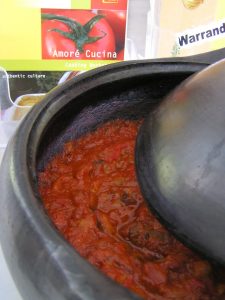We grew up with this cultural food ritual and we used to be embarrassed about it! Now I am proud to be part of the generation that has come full circle and I want to share this part of my story with the world. Tomato Day comes around each year at the end of summer. It used to be on the long weekend in Melbourne. We call it “Sarsa” which is dialect for sauce. Not the kind you put on your pie, but the one that goes with pasta. It has no preservatives, nothing artificial only the goodness of seasonal flavour. Oh, a bit of basil in the bottom of the jar. One day’s work brings everyone together and makes enough to see you through the whole year.
If you would like to join a group (or have a group of 4-6) to make it, please call 0407 687 971 to lock in a date!
These are just some of the questions I get asked about this amazing tradition:
Is tomato puree the same as Passata?
The tomato sauce, otherwise known as puree, is now more commonly known as passata. It is tomatoes cut up, boiled briefly, squashed through a machine, put into jars/bottles with fresh basil, capped and boiled for about an hour. The sauce is then stored in a pantry or cellar and used as required.
Who makes Passata?
People who make passata love the flavours and taste of their own home cooking. Passata has been made at home for generations by Europeans, especially Italians who brought these traditions to Australia during the fifties.
Many people who plant tomatoes for the summer make jars of passata from their own home grown produce.
Why make hundreds of jars of Passata?
It’s good to make lots of jars of passata to store in the pantry for the year ahead.
We used to recycle empty beer bottles. They were dark and easy to re-cap with new lids and this is the way my mum worked it out:
Once a week (therefore 52 bottles) we would have pasta with ragú, which is made of young lamb, goat or pieces of osso buco which are quickly browned and then the passata is poured on top to simmer for about 2 hours for a delicious, rich pasta sauce.
Every now and then (Italian for once a week – allow 50 bottles) a bottle of passata was stirred into vegetables or with chick peas or lentils. This makes a lighter sauce and can be used with small shaped pasta or rice.
Every couple of weeks (allow 30 bottles) we would make something different eg pasta al forno or lasagne and we loved to make our own baked beans. With pieces of our own home made proscuitto or salami, some soaked canellini or kidney beans and some gently fried garlic, onion, celery and carrot. All this was then transferred to a baking dish with a bottle or two of ‘sarsa’ and slow baked for a couple of hours – much better than tinned.
Occasionally we had special celebrations, birthday, anniversary or guests (from overseas perhaps!) and we would use two or three bottles for a lasagne or other festive dish like eggplant parmigiana. This meant at least another 30 bottles, because it’s best to have extra and never go short!





Recent Comments